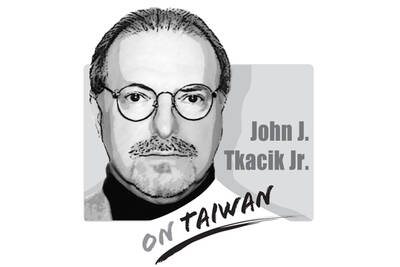Tropical Storm Atsani was the only storm this year for which the Central Weather Bureau issued a land warning. Since 1949, the bureau has issued typhoon warnings for only 17 typhoons and tropical storms in November, which is an average of one warning every four years.
Everyone was hoping that Atsani would replenish the water levels of reservoirs in central and southern Taiwan, but the storm did not live up to expectations.
The Water Resources Agency used land-based cloud seeding in an attempt to increase rainfall over reservoirs, but it did not use airborne cloud seeding, which is more effective.
This was because the government did not dispatch transport planes, due to unpredictable risks associated with the storm.
Taiwan has experienced abnormal weather this year, causing water resources to diminish rapidly. As a result, reservoirs in central and southern areas, which are normally full or close to full in October, are actually less than one-third full.
For example, Taiwan’s largest reservoir — Zengwen Reservoir (曾文水庫) in Chiayi County — is at only 23 percent of its capacity, compared with 77 percent at the same time last year and 78 percent the year before.
The government has reduced or cut off water supplies for the second rice crop and diverted it for household and industrial use, but if no more tropical storms or typhoons visit Taiwan before the end of this year, Taiwanese will somehow have to get through the four months before next year’s spring and summer rains arrive. Everyone in Taiwan had better wake up to the threat of a worsening drought.
The heavens only give people so much water, even at the best of times, so everyone must comply with national water resource allocations by using water sparingly.
It is hard to go from extravagance to frugality, so everyone in Taiwan should to try hard to reduce unnecessary use of water. Let us revive the Taiwanese tradition of frugality and join hands to get through this drought together.
Lai Ming-huang holds a doctorate in engineering from National Cheng Kung University and is a former secretary-general of the Chiayi City Government.
Translated by Julian Clegg
Chinese agents often target Taiwanese officials who are motivated by financial gain rather than ideology, while people who are found guilty of spying face lenient punishments in Taiwan, a researcher said on Tuesday. While the law says that foreign agents can be sentenced to death, people who are convicted of spying for Beijing often serve less than nine months in prison because Taiwan does not formally recognize China as a foreign nation, Institute for National Defense and Security Research fellow Su Tzu-yun (蘇紫雲) said. Many officials and military personnel sell information to China believing it to be of little value, unaware that
Before 1945, the most widely spoken language in Taiwan was Tai-gi (also known as Taiwanese, Taiwanese Hokkien or Hoklo). However, due to almost a century of language repression policies, many Taiwanese believe that Tai-gi is at risk of disappearing. To understand this crisis, I interviewed academics and activists about Taiwan’s history of language repression, the major challenges of revitalizing Tai-gi and their policy recommendations. Although Taiwanese were pressured to speak Japanese when Taiwan became a Japanese colony in 1895, most managed to keep their heritage languages alive in their homes. However, starting in 1949, when the Chinese Nationalist Party (KMT) enacted martial law

“Si ambulat loquitur tetrissitatque sicut anas, anas est” is, in customary international law, the three-part test of anatine ambulation, articulation and tetrissitation. And it is essential to Taiwan’s existence. Apocryphally, it can be traced as far back as Suetonius (蘇埃托尼烏斯) in late first-century Rome. Alas, Suetonius was only talking about ducks (anas). But this self-evident principle was codified as a four-part test at the Montevideo Convention in 1934, to which the United States is a party. Article One: “The state as a person of international law should possess the following qualifications: a) a permanent population; b) a defined territory; c) government;
The central bank and the US Department of the Treasury on Friday issued a joint statement that both sides agreed to avoid currency manipulation and the use of exchange rates to gain a competitive advantage, and would only intervene in foreign-exchange markets to combat excess volatility and disorderly movements. The central bank also agreed to disclose its foreign-exchange intervention amounts quarterly rather than every six months, starting from next month. It emphasized that the joint statement is unrelated to tariff negotiations between Taipei and Washington, and that the US never requested the appreciation of the New Taiwan dollar during the